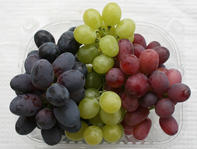Table grapes are grapes produced for fresh consumption as a fruit. This sets them apart from grapes produced for making grape juice, wine or raisins.

The grapevine is known as Vitis vinifera and is native to the Mediterranean region. The cultivation of the domesticated grape has an ancient history, which began around 6 000 years ago in the Middle East.
Grapes are a fruit, which consist of bunches of berries. The bunches of grapes grow on vines, which flower in early spring, with the tiny blossoms pollinated both by bees and by wind pollination. The bunches of grapes grow and develop through spring and are ready for harvest from early to late summer.
Grape vines are deciduous, as in autumn the vines lose their leaves and bud again with new leaf growth at the end of winter. The grapes grow on a vine and for commercial table grape production, vines are trained up onto a trellis.
This is done to raise the vine off the ground and to allow the vine canopy to spread on the trellis to facilitate production practices. Without the support of a trellis, vines spread across the ground or climb up nearby structures like creepers.
Grapes are propagated by cuttings and due to the presence of diseases in the soil such as phylloxera, most grape vines are grafted and consist of two different varieties. The desired variety for production grows above the ground but is grafted onto a disease-resistant rootstock vine. Table grapes have seeded and seedless varietals. Today seedless varieties are the most popular varieties.
Grapes range widely in terms of colour, berry size and shape, as well as flavour and suitability to regional growing conditions. The three main grape colour categories are black (purple to black grapes), red (crimson, red and pink grapes) and white (yellow-green to milky green grapes). Grapes are non-climacteric fruit, which means that they do not ripen any further once they have been harvested.
 South Africa has been producing and exporting table grapes for more than a century. The industry produces grapes mainly for the export marke...
South Africa has been producing and exporting table grapes for more than a century. The industry produces grapes mainly for the export marke...